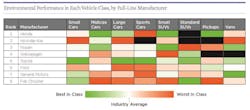Every few years, the Union of Concerned Scientists takes a look at the auto industry’s emission reduction progress as part of our Automaker Rankings series of reports. This year’s analysis, based on model year (MY) 2017 vehicles, shows that the industry has once again reached the lowest levels yet in both smog-forming and global warming emissions from new vehicles, despite the fact that many off-the-shelf technologies are deployed in less than one-third of all new vehicles. Unfortunately, this record-setting trend in progress also shows some indications of slowing down, with Ford and Hyundai-Kia showing no progress towards reducing global warming emissions, and Toyota actually moving backwards.
At the same time, the industry spearheaded an effort to re-litigate fuel economy and emissions standards set through 2025, and this report comes out while a proposal from the current administration responding to their request that would completely halt progress in the industry at 2020 levels sits awaiting public release. Therefore, while this year’s Automaker Rankings highlights some of the progress made by leaders in the industry to move forward on the technology front, it’s also critical that on the political front these companies stand up to the administration to ensure the rest of the industry continues to move forward on reducing emissions.
The Technology to Meet Future Standards is Out There
For me, one of the key takeaways from this report is that while standards have in many cases accelerated the deployment of new technologies, some of the most cost-effective strategies to reduce emissions are still sitting on the shelf. The industry’s progress to-date is barely a glimpse of where gasoline-powered vehicles could be in the future as shown in the figure below.On top of this, many of the deployed technologies, like advanced transmissions, still have significant incremental progress that can be made. We’re also seeing novel developments in other technologies like start-stop, where we are beginning in 2018 to see the deployment of higher-voltage (48V) systems that can result in complementary technology such as electric boost and again continue to push out the horizon for combustion engine improvements. For this and many other reasons, it’s baffling to see the industry assert that meeting 2025 vehicle standards requires widespread vehicle electrification.
No More Greenest Automaker
Of course, electric vehicles are one of the reasons for a key difference in this year’s report: we are now including the results of all automakers, not just those largest companies who sell vehicles of all sizes and types. A lot of the development for some of the technologies that could pave the way to a lower-emissions future are coming from some of the smallest manufacturers, whether that’s Tesla’s all-electric fleet or Mazda’s SkyActiv-X spark-assisted charge compression engine, which looks to bring diesel-like operation to a gasoline engine. Ignoring this leadership from smaller automakers would be ignoring some of the most forward-looking technology deployment in the industry.
Additionally, it’s important to recognize that this report is limited to the emissions of the vehicles sold by manufacturers—it does not consider other aspects of operations which also affect the sustainability and “greenness” of a company, whether that’s related to water use at its facilities, renewable power sourcing, or other aspects of the manufacture and distribution of a manufacturer’s fleet.
Considering these two central limitations, we have decided to no longer award a “Greenest Automaker.” It’s important to recognize the wide difference between the emissions from the fleet of Honda, who has again asserted its leadership to provide the lowest emission fleet from full-line automakers, and Fiat Chrysler, who finds itself producing a fleet better only than McLaren, Ferrari, and Aston Martin—automakers who produce only exotic sports cars meant more for a track than a highway—but that is only part of the story.
The Gap Between Leaders and Laggards Is Huge
One of the reasons we have previously ignored small manufacturers is that they provide a narrow spectrum of vehicles—and it’s been a historic complaint from companies like Ford that they should get a pass because people want big trucks. But one of the key findings from this year is that the Detroit Three fall to the bottom of the pack not because they sell big trucks, but because in virtually all classes of vehicles they sell, their cars and trucks emit more than the rest of the industry. And the reverse is true for a company like Honda.
The only company whose ranking is significantly affected by the mix of vehicles they sell is Toyota—but that was an intentional decision on their part. They chose to boost production of their least efficient vehicles, trucks and SUVs, while at the same time bypassing investment in improving those vehicles. If they want to catapult back to the top of the pack, they’ll need more than the Prius to make them look like a leader—it’s about providing consumers lower emission choices across the entire spectrum of vehicles sold.
A Path Forward
With every Automaker Rankings, we try to provide the industry with a path forward. And the truth is, the engineers at these companies have been working their butts off to provide a bright future for the industry…should they choose to embrace it.
Manufacturers have made a number of pronouncements about the vehicles planned over the next five years which could easily end up keeping emissions levels on the path envisioned under the 2025 standards now on the books. And we have tried to highlight the role these vehicles can play in creating a more sustainable transportation future.
But too many within the industry have been looking to ignore their role in getting to this low-emissions future, so the question remains: Will the industry accelerate toward a cleaner future by following their engineers, or continue to deploy their lobbyists to slam on the brakes?
Dave Cooke is a senior vehicles analyst in the UCS Clean Vehicles Program, specializing in both light- and heavy-duty fuel economy.
This article originally appeared in the Union of Concerned Scientists blog.






